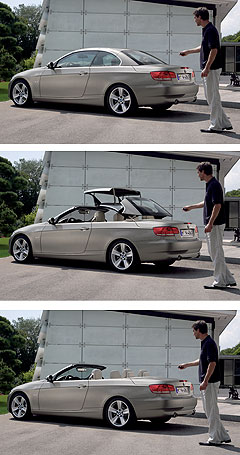Make / Model Search
Future models - BMW - 3 Series - ConvertibleFirst look: BMW 3 Series convertible flips its lidSleek lines: The convertible follows the same styling themes of the coupe. BMW moves away from a soft-top for its next-gen 3 Series Convertible25 Oct 2006 BMW has unveiled its fourth-generation 3 Series convertible, ahead of its first public engagement at the North American International Auto Show in January. Due to arrive in Australia late next year, the four-seater convertible has made the move to a folding hard-top roof, which makes it BMW's first folding metal-roofed model. It will also make 3 Series the only model available in both fixed-roof coupe and folding-roof coupe-convertibles guises. BMW claims its latest convertible is the first car in the world to offer "sun-reflective" leather seat trim as well as a load-through luggage facility, although Audi’s A4 cabrio has a similar facility. To be sun-reflective, the leather trim is embedded with pigments designed to reflect infrared radiation, and BMW claims the seats can be up to 20 degrees cooler compared to untreated leather. The electric three-piece roof can be stowed or raised in around 22 seconds and can be opened and closed remotely via the key. The cleaner roof design allows for improved rearward visability over the current rag-top, by a claimed 38 per cent through the rear and 30 per cent through the side rear glass. The folding roof offers luggage volume of 210 litres with the top down, or 350 litres when raised. BMW claims it has also has been designed for speeds of up to 270km/h, allowing for the possibility of M variants at some point in the future.  Visually the convertible continues the low shoulder-line so typical of a BMW convertible, complete with its low-slung rear section, which unlike other coupe-convertibles is parallel to the ground and necessitated a five-piece roof section. Visually the convertible continues the low shoulder-line so typical of a BMW convertible, complete with its low-slung rear section, which unlike other coupe-convertibles is parallel to the ground and necessitated a five-piece roof section.Like the coupe, the short front overhang, long bonnet and long wheelbase also enhance the car's sporty on-road stance. The car is 200kg heavier than the coupe with the extra weight resulting from additional support members in the floor as well as the electric motors and hydraulics required to open and close the roof. To help minimise weight, the mudguards are plastic, weighing 50 per cent less than conventional steel panels. The plastic panels are made of a special synthetic material that mean they can be fitted and painted through the regular production process. Like the coupe, the convertible has a strong, ultra-safe body. The bulkhead support is made of innovative, extra-strong multi-phase steel, longitudinal profile bars, reinforcements as well as the extra strong luggage compartment floor, rear and side panels minimise impact forces from behind. In a side impact the crash forces are diverted through the car's reinforced floorpan. The side-sills are made of tailored rolled blanks and a designed to interact with the doors, seats and the instrument panel to ensure the cabin resists intrusion between the A-pillars. The convertible will be offered around the world with a number of familiar 3 Series engines, with a 225kW 3.0-litre straight-six twin-turbo 335i variant leading the charge. Other petrol engines/model variants (all with direct fuel-injection) include a 200kW 3.0-litre straight-six in the 330i, a 160kW version in the 325i and a 125kW 2.0-litre inline-four in the baseline 320i. As with the 3 Series coupe and, soon, the 3 Series sedan, Australians will be offered the choice of only the 335i and 325i convertibles. On the diesel front, there is a 170kW/500Nm 3.0-litre straight-six common-rail turbo-diesel in the 330d. All future models Alfa Romeo Alfa Romeo Abarth Abarth Alpine Alpine Alpina Alpina Audi Audi Aston Martin Aston Martin BMW BMW Bentley Bentley Chery Chery Brabham Brabham Chrysler Chrysler Chevrolet Chevrolet Cupra Cupra Citroen Citroen DS DS Dodge Dodge Fiat Fiat Ferrari Ferrari Foton Foton Ford Ford Great Wall Great Wall FPV FPV Haval Haval GWM GWM Honda Honda Holden Holden Hummer Hummer HSV HSV Infiniti Infiniti Hyundai Hyundai Jaguar Jaguar Isuzu Isuzu Kia Kia Jeep Jeep Land Rover Land Rover Lamborghini Lamborghini Lexus Lexus LDV LDV Mahindra Mahindra Lotus Lotus Mazda Mazda Maserati Maserati Mercedes-AMG Mercedes-AMG McLaren McLaren MG MG Mercedes-Benz Mercedes-Benz Mitsubishi Mitsubishi Mini Mini Opel Opel Nissan Nissan Peugeot Peugeot Pagani Pagani Proton Proton Porsche Porsche Renault Renault Ram Ram Rover Rover Rolls-Royce Rolls-Royce Skoda Skoda Saab Saab SsangYong SsangYong Smart Smart Suzuki Suzuki Subaru Subaru Toyota Toyota Tesla Tesla Volvo Volvo3 Series pricing
Motor industry news |
Click to shareBMW modelsAll future models Alfa Romeo Alfa Romeo Abarth Abarth Alpine Alpine Alpina Alpina Audi Audi Aston Martin Aston Martin BMW BMW Bentley Bentley Chery Chery Brabham Brabham Chrysler Chrysler Chevrolet Chevrolet Cupra Cupra Citroen Citroen DS DS Dodge Dodge Fiat Fiat Ferrari Ferrari Foton Foton Ford Ford Great Wall Great Wall FPV FPV Haval Haval GWM GWM Honda Honda Holden Holden Hummer Hummer HSV HSV Infiniti Infiniti Hyundai Hyundai Jaguar Jaguar Isuzu Isuzu Kia Kia Jeep Jeep Land Rover Land Rover Lamborghini Lamborghini Lexus Lexus LDV LDV Mahindra Mahindra Lotus Lotus Mazda Mazda Maserati Maserati Mercedes-AMG Mercedes-AMG McLaren McLaren MG MG Mercedes-Benz Mercedes-Benz Mitsubishi Mitsubishi Mini Mini Opel Opel Nissan Nissan Peugeot Peugeot Pagani Pagani Proton Proton Porsche Porsche Renault Renault Ram Ram Rover Rover Rolls-Royce Rolls-Royce Skoda Skoda Saab Saab SsangYong SsangYong Smart Smart Suzuki Suzuki Subaru Subaru Toyota Toyota Tesla Tesla Volvo Volvo3 Series pricing
Motor industry news |









Facebook Twitter Instagram